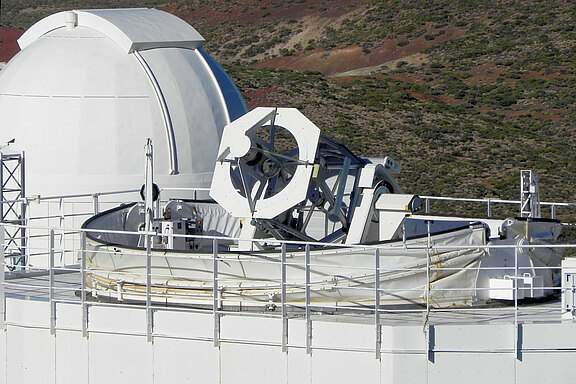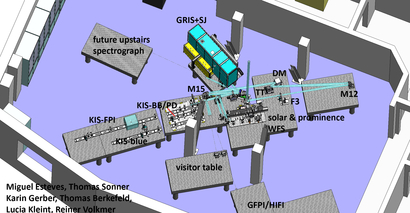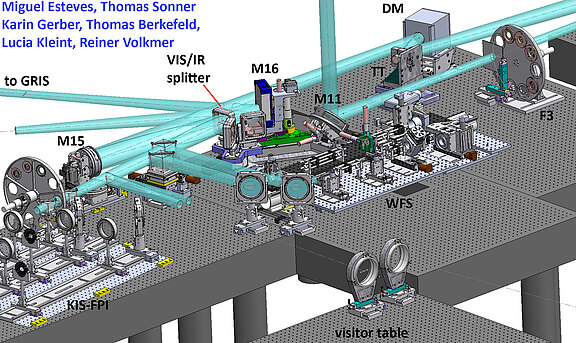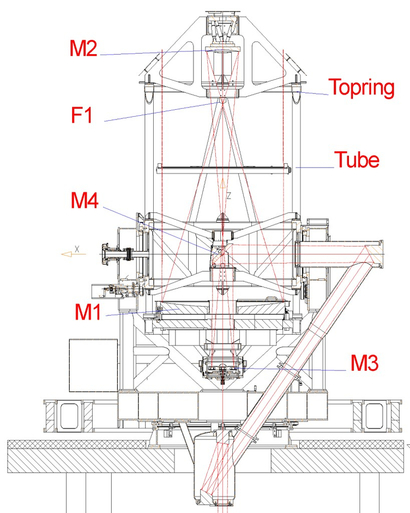Telescope Dome and Structure
GREGOR has an open foldable dome which minimises local turbulence and dome seeing. The mechanical structure of the telescope is an open, stiff Serrurier with an altitude-over-azimut mount. The self resonance of the structure is about 12 Hz. The surface finish of all parts is such that the temperature difference to ambient air remains within 0.2°C. Tracking accuracy is within 0.2 to 0.5 seconds of arc, absolute pointing better than 1 second of arc, for wind speeds of up to 20 m s-1. The telescope structure was installed in 2004.
Optical Characteristics
The telescope optics is a Gregorian configuration with three powered mirors. The parabolic 1.5m diameter primary mirror M1 has a focal ratio of f/1.7 and is actively temperature contolled to within 0.5°C from ambient air. A cooled field stop at the primary focus F1 limits the field of view to 150 arc sec or 300 arc sec. The remaining sunlight is reflected outside the structure. The elliptical secondary mirror M2 magnifies the primary image at the secondary focus which is about 200mm above the elevation axis. A secondary focus unit contains remotely controlled field stops, a target, and a polarimetric calibration unit. An elliptic tertiary mirror M3 and coudé optics with four plane mirrors (M4 - M8) direct the light beam through the telescope structure and form the tertiary focus F3 at a fixed position in the laboratory underneath the telescope platform with a final focal ratio of f/38 (feff = 55.6m). The alignment between M1 and M2 is controlled via a hexapod on which M2 is mounted. The axial position of F3 can be adjuted by an axial shift of M2 or M3. Image rotation is controlled with a derotator before F3 which introduces another three mirrors (M9 - M11) into the beam.
Instrument Laboratory as of 2020
The instrument laboratory is located in the fifth floor of the GREGOR building, directly below the telescope platform. All post-focus instruments are located here, with the exception of the major part of GRIS in the spectrograph room on the fouth floor. The instrument laboratory was completely reconfigured in 2020 in order to considerably improve the stability and the imaging quality of the adaptive optics relay between F3 and F4. Also, parallel obervations of several instruments in different spectral regimes has been made easier. The replacement of the former toric relay optics mirrors (M12 and M15) by off-axis paraboloid mirrors has eliminated field-dependent aberrations, mainly astigmatism and coma. Imaging between F3 and F4 is now diffraction limited for visible wavelengths throughout the field of view.
The new configuration has the following characteristics:
- More space for post-focus instruments and a future multi-conjugated AO system
- Horizontal tables for all optics with better stability and much easier adjustment
- Arrangement of the wave front sensor following M15, thereby compensating all powered optics
- 49mm diameter pupil to match existing tip-tilt and deformable mirrors
- 1:1 magnification between F3 anf F4
- Aberration-free image quality within 60 arcsec radius
- Exchangeable dichroic beam splitter in front of F4 reflects visible spectral range and transmits IR for GRIS
- No reconfiguration of GRIS entrance slit unit required
- Small angles of incidence on beamspitters for less instrumental polarization and better polarimetry
- Telecentric exit pupil
The existing pentaprisms are replaced by dichroic beam splitter plates with smaller angles of incidence. There are two plates with a transition wavelength of 650nm and 900nm, which allows observing the H-alpha spectral region either with a visible instrument or with an H-alpha channel in the slit viewing system for GRIS.
For more information see GRE-KIS-TN-0019.
Control System
GREGOR's control system consists of several modules. Telescope pointing and tracking, the motors on the telescope structure and the M1 cooling are controlled by a system delivered by the manufacturer of the telescope structure. The GREGOR Control System (GCS) provides the graphical user interface for telescope operation, computes ephemerides and generates the low level commands for the telescope control. GCS also controls the derotator and other optical components on the telescope. GCS has received a new GUI in 2019 which unifies many of the formerly distributed functions and makes operating the telescope much easier. The operation of telescope and instruments is done from an observing room on the third floor to minimise human activity in the instrument lab on the fifth floor while observing.
The AO system and the post-focus instruments have separate GUIs and communicate with GCS via a standardised protocol.



